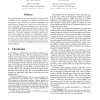Free Online Productivity Tools
i2Speak
i2Symbol
i2OCR
iTex2Img
iWeb2Print
iWeb2Shot
i2Type
iPdf2Split
iPdf2Merge
i2Bopomofo
i2Arabic
i2Style
i2Image
i2PDF
iLatex2Rtf
Sci2ools
IWPC
1999
IEEE
1999
IEEE
Understanding COBOL Systems using Inferred Types
In a typical COBOL program, the data division consists of 50% of the lines of code. Automatic type inference can help to understand the large collections of variable declarations contained therein, showing how variables are related based on their actual usage. The most problematic aspect of type inference is pollution, the phenomenon that types become too large, and contain variables that intuitively should not belong to the same type. The aim of the paper is to provide empirical evidence for the hypothesis that the use of subtyping is an effective way for dealing with pollution. The main results include a tool set to carry out type inference experiments, a suite of metrics characterizing type inference outcomes, and the conclusion that only one instance of pollution was found in the case study conducted.
Automatic Type Inference | IWPC 1999 | Software Engineering | Type Inference | Typical Cobol Program |
Related Content
| Added | 04 Aug 2010 |
| Updated | 04 Aug 2010 |
| Type | Conference |
| Year | 1999 |
| Where | IWPC |
| Authors | Arie van Deursen, Leon Moonen |
Comments (0)

